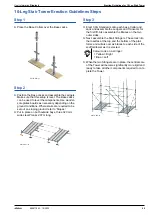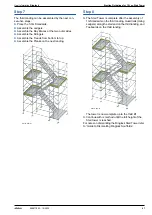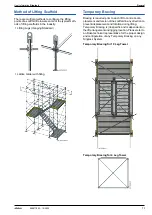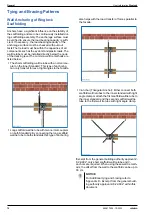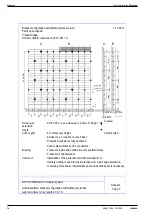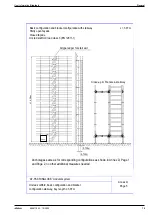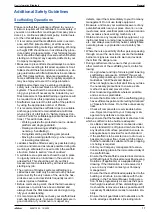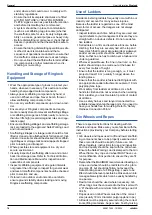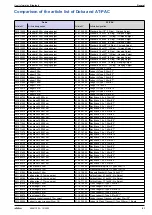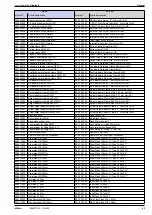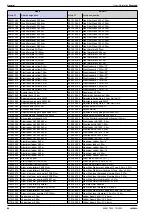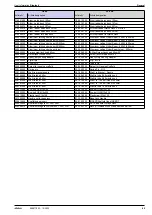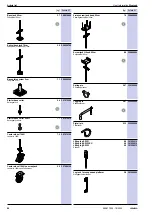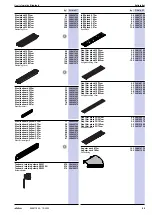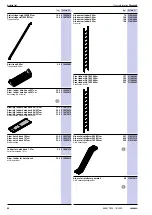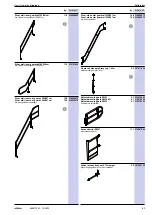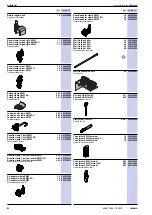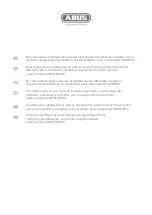
78
999817902 - 10/2022
General
User Information
Ringlock
ends) where a fall could occur, to comply with
statutory regulations.
- Ensure that all incomplete structures are fitted
with 'DO NOT USE' or 'SCAFFOLD INCOM-
PLETE' signs as soon as possible after erection
and before dismantling has commenced.
- A system should be in place to communicate
(such as a scaffolding tag procedure) whether
the scaffold is safe for use, its duty rating/suita-
bility i.e. access, general purpose or heavy duty.
- Before dismantling is commenced, check that all
ties are in position and that the scaffold is safe to
access.
- Ensure that during dismantling operations a safe
method of work is maintained and that a
sequence of operations is adopted to ensure that
the scaffold is stable and secure at each stage.
- Do not overload the scaffold with stored scaffold-
ing components or other materials, when dis-
mantling or re-erecting.
Handling and Storage of Ringlock
Equipment
▪
Wear the appropriate type of gloves to protect your
hands, whenever necessary. Take extra care when
handing sharp-edged metal components.
▪
Always pass scaffolding components by hand, or
use a Gin Wheel and rope. Never bomb, throw or
allow scaffolding components to fall.
▪
Do not carry scaffold components up or down a lad-
der.
▪
Ensure all your Ringlock components and equip-
ment are neatly stored in relevant scaffolding stillage
or scaffolding storage rack. Stack neatly to no more
than five lifts high (local site/regional rules and regu-
lations apply)
▪
Ensure scaffolding stillage's and scaffolding storage
rack are loaded to the approved Safe Working Load
and not overloaded.
▪
Scaffolding stillages or storage racks should be fork
lifted or craned onto a flatbed truck for transport. Indi-
vidual or loose items should be stacked into scaffold-
ing stillages or storage racks and wrapped/ strapped
prior to loading and transport.
▪
Where possible store all equipment in a dry and
secure environment.
▪
Visually inspect all scaffolding after use and arrival
back into storage area. Refer to Technical Informa-
tion and Maintenance Manual for inspection and
quarantine of components.
▪
Inspect scaffolding equipment at regular intervals
not greater than 30 days to inspect for general wear
and tear. All scaffold components should be checked
prior to erection and use.
▪
If stored in an outdoor environment be careful to
ensure ground stability when stacking and moving
Ringlock scaffolding components.
Use of Ladders
Accidents involving ladders frequently occur within our
industry and account for many serious injuries.
Because the ladder is regarded as one of the most
basic forms of access, the dangers are not always
anticipated.
▪
Inspect ladders each time before they are used and
report defects to your management. Ensure they are
straight with no obvious defects. Do not use defec-
tive ladders.
▪
Set ladders on a firm and level base. Ensure, before
climbing, that they are securely tied at the top and
footed such that it cannot slip outwards or sideways.
Ladder access points should be without obstruc-
tions, so that no one has to climb over a toeboard or
under a guardrail.
▪
Wherever possible use the 'one in four rule' i.e. the
ladder should slope one metre out at the base for
every four metres of height.
▪
Ensure that the ladder is long enough, i.e. it must
project at least 1.0
m (usually 5 rungs) above the
landing place.
▪
Ensure that the Ladder is fastened to Ringlock with
an appropriate Ladder attachment coupler or 18
mm
polypropylene rope.
▪
Work safely from ladders at all times. Use both
hands to climb and do not overreach when working
from a ladder, you must maintain 3 points of contact
at all times.
▪
Use a safety harness and lanyard connected to a
suitable independent anchorage point, if you need to
have your hands free for working. Refer to 'Safety
Harness Connection Points'.
Gin Wheels and Ropes
There are special instructions for dealing with Gin
Wheels and ropes. Make sure you are familiar with the
instructions provided by your Company before starting
work.
▪
Gin wheels and ropes used to lift and lower scaffold-
ing components have to be properly examined and
these records should be kept for future use. Gin
Wheel registers, instructions for use and inspection
and rope quality should be kept with the Gin wheel.
Ensure the Safe Working Load is stamped to the Gin
Wheel frame. Any rope and wheel MUST have cur-
rent certification of inspection to ensure they are fit
for purpose.
▪
Remember the MAXIMUM recommended loading on
a rope and wheel should be restricted to 25
kg
for
a
one man lift, but should definitely not exceed the
Safe Working Load of a Fittings Bag. Loads to be
lifted should wherever possible be broken down into
manageable weights which can be easily handled by
one person.
▪
Davit arms should be used where necessary. Gin
Wheel rings must be connected to the Davit arm with
a 'D' shackle with a minimum Safe Working Load of
30
kN.
▪
Ropes used on Gin Wheels must be of the correct
size (usually 18
mm diameter polypropylene rope).
▪
All loads must be properly secured using the correct
knots, lifting containers, bags or nets. Test by raising


